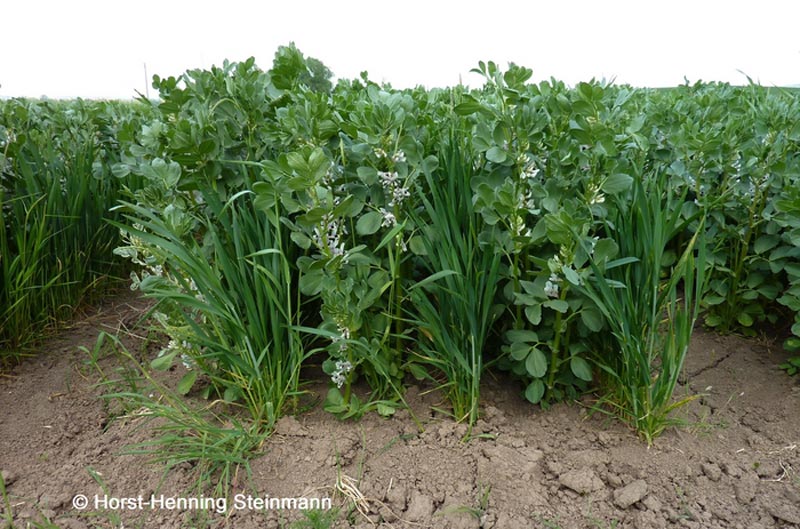
Wheat-Bean Crop Mixtures Boost Pollinator Habitats

A mixture of crops: faba bean and wheat
Credit: Horst-Henning Steinmann
Researchers at Göttingen University investigate attractiveness of wheat-bean crop mixtures for pollinating insects.
There are often too few flowering plants in agricultural landscapes, which is one reason for the decline of pollinating insects. Researchers at the University of Göttingen have now investigated how a mixture of crops of faba beans (broad beans) and wheat affects the number of pollinating insects. They found that areas of mixed crops compared with areas of single crops are visited equally often by foraging bees. Their results were published in the journal Agriculture, Ecosystems & Environment.
The researchers observed and counted foraging honeybees and wild bees in mixtures of wheat and faba bean and in pure cultures that only contained faba beans. “We had expected that the mixed crops with fewer flowers would be visited less frequently by bees for foraging than single crops,” says PhD student Felix Kirsch from the Functional Agrobiodiversity research group, University of Göttingen. “To our surprise, this was not the case.”
This could be due to several reasons. “Our mixed cultures were less dense than pure cultures, which possibly increased the visibility of the flowers. This might have attracted the similarly large number of bees to the mixed cultures,” suggests Dr Annika Haß, postdoctoral researcher in the Functional Agrobiodiversity research group. “In addition, reduced competition between the faba bean plants in mixed cultures could mean that they can invest more resources in the production of nectar and pollen to increase their attractiveness to bees,” adds Professor Wolfgang Link, head of the group for Breeding Research Faba Bean.
“Mixed cultivation of wheat and faba bean has also other advantages for crop production,” says Professor Catrin Westphal, Head of Functional Agrobiodiversity. For instance, yields per bean plant were higher in mixed crops than in pure cultures. “Cereal crops can be ecologically enhanced by adding legumes such as beans or lentils. This can make a valuable contribution to increasing the abundance of flowers on the arable land and thus counteracting pollinator decline,” concludes Haß.
Original publication: Kirsch, F., Hass, A. L., Link, W. und Westphal, C. (2023): Intercrops as foraging habitats for bees: Bees do not prefer sole legume crops over legume-cereal mixtures. Agriculture, Ecosystems & Environment, https://doi.org/10.1016/j.agee.2022.108268.
Contact:
Felix Kirsch
University of Göttingen
Faculty of Agricultural Sciences
Functional Agrobiodiversity
Grisebachstraße 6, 37077 Göttingen, Germany
Tel: +49 (0)551 / 39-33739
Email: felix.kirsch@uni-goettingen.de
Professor Catrin Westphal
University of Göttingen
Faculty of Agricultural Sciences
Department of Functional Agrobiodiversity
Grisebachstraße 6, 37077 Göttingen, Germany
Tel: +49 (0)551 / 39-22257
Email: catrin.westphal@uni-goettingen.de
Journal: Agriculture Ecosystems & Environment
Method of Research: Experimental study
Subject of Research: Not applicable
Article Title: Intercrops as foraging habitats for bees: Bees do not prefer sole legume crops over legume-cereal mixtures
Article Publication Date: 28-Feb-2023
Media Contact
Melissa Sollich
University of Göttingen
melissa.sollich@uni-goettingen.de
Office: 49-551-392-6228












